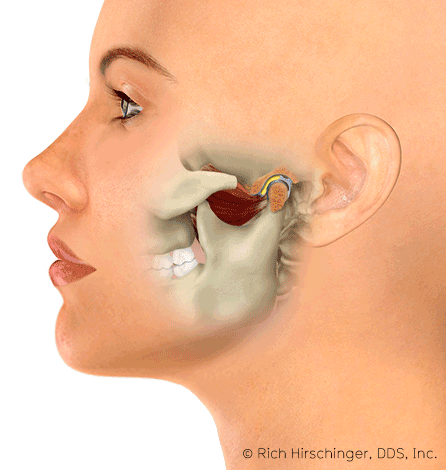TMJ / TMD
The Temporomandibular Joint (TMJ) is where your jaw articulates with your skull just in front of your ear. If you have been having pain and/or clicking in the TMJ you will know exactly where it is and how life altering TMJ syndrome or temporomandibular disorder (TMD) can be. At worst the TMJ can dislocate and cause peoples jaw to get stuck open. Usually TMD presents as pain and/or clicking in one or both joints during mastication (chewing).
Chiropractors are joint specialists and the TMJ is anatomically similar to other joints in the human body but has its nuances.
Anatomy of the TMJ
The TMJ is unique among the other joints in the human body. It is loose packed, meaning that it can move quite a bit. This movement is quite necessary to get our mouths open wide enough for many foods. As you open your mandible (jaw) the joint initially acts like a pivot allowing the jaw to pivot down, opening the oral cavity. About half way through, the jaw starts protruding (moving forward) to allow more clearance. This forward glide is most often the source of TMJ problems. This is were are some muscles and ligaments that are supposed to do the work effortlessly. Additionally, there is a disc (yes a disc, much like in the spine) located between the mandible and the temporal bone that cushions the joint while facilitating the forward gliding motion.When you hear or feel that click, what you are hearing is the mandible sliding off or back onto that disc during the mandibular gait cycle (chewing). This is TMD.
Treatment of TMD
There are literally hundreds of different treatments for TMD. In fact there are medical clinics that only treat TMD. Its common and its a problem for those affected. I think that a chiropractor or a physical therapist is a good first point of care for most TMJ problems. At the very least we can tell you its beyond conservative treatment and send you the way of the TMD specialists. At best, a simple and cost effective treatment may be all that you need.
Soft-Tissue Work
As discussed above, there are several muscles involved in the TMJ both directly and indirectly. My first approach for most TMJ problems is a few minutes of soft-tissue work a few time a week for a few weeks. Most of the time this is all that is needed to receive praise from satisfied patients.
Acupuncture / Dry Needling
Some patients respond well to acupuncture for the TMJ. Its generally a bit more expensive than soft-tissue work but its a lot more comfortable.
Joint Manipulation
It is important to note that joint manipulation is never a quick fix. Can it help with TMJ? Yes absolutely! Restoring optimal motion of joints is what chiropractors are all about. However, it may not be the most comfortable treatment but most patients tolerate it just fine. In fact, I have never been asked to stop due to discomfort. I think the reward is worth it for most patients.
Bite Blocks and Oral Orthotics
Bruxism (clenching you jaw / grinding your teeth is common to the majority of TMJ problems. A bite block, sleep guard, or high dollar custom orthotic may be of benefit. We don't stock any of these but the cheaper options can usually be obtained at your local pharmacy.
Surgery / Injections
The old steroid injection is a go to for physicians who prefer a hands-off model and its use is fairly standard in the US. Injections, like most other things don't have the best evidence but effectiveness is there. More invasive and with higher risk the injection route is typically the next step after conservative care. While surgery for TMD is rare, there are cases that require it.
Of note: The TMJ is one of those joints that autoimmune joint diseases like rheumatoid arthritis loves to attack. So, if you have an autoimmune disease, it is important to treat that before working on the TMJ.

